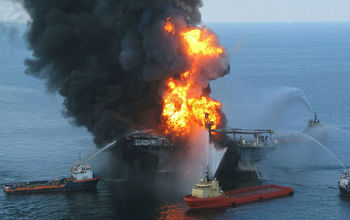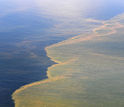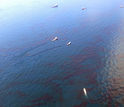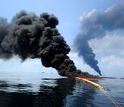News Release 14-143
Where did the Deepwater Horizon oil go? To Davy Jones' Locker at the bottom of the sea
New analysis traces oil to its resting place on the Gulf of Mexico sea floor

Oil remains in the Gulf of Mexico more than four years after the Deepwater Horizon spill.
October 27, 2014
This material is available primarily for archival purposes. Telephone numbers or other contact information may be out of date; please see current contact information at media contacts.
Where's the remaining oil from the 2010 Deepwater Horizon disaster in the Gulf of Mexico?
The location of 2 million barrels of oil thought to be trapped in the deep ocean has remained a mystery. Until now.
Scientist David Valentine of the University of California, Santa Barbara (UCSB) and colleagues from the Woods Hole Oceanographic Institution (WHOI) and the University of California, Irvine, have discovered the path the oil followed to its resting place on the Gulf of Mexico sea floor.
The findings appear today in the journal Proceedings of the National Academy of Sciences.
"This analysis provides us with, for the first time, some closure on the question, 'Where did the oil go and how did it get there?'" said Don Rice, program director in the National Science Foundation's (NSF) Division of Ocean Sciences, which funded the research along with NSF's Division of Earth Sciences.
"It also alerts us that this knowledge remains largely provisional until we can fully account for the remaining 70 percent."
For the study, the scientists used data from the Natural Resource Damage Assessment conducted by the National Oceanic and Atmospheric Administration.
The U.S. government estimates the Macondo Well's total discharge--from April until the well was capped in July--at 5 million barrels.
By analyzing data from more than 3,000 samples collected at 534 locations over 12 expeditions, the researchers identified a 1,250-square-mile patch of the sea floor on which four to 31 percent of the oil trapped in the deep ocean was deposited. That's the equivalent of 2 to 16 percent of the total oil discharged during the accident.
The fallout of oil created thin deposits that are most extensive to the southwest of the Macondo Well. The oil is concentrated in the top half-inch of the sea floor and is patchily distributed.
The investigation focused primarily on hopane, a nonreactive hydrocarbon that served as a proxy for the discharged oil.
The researchers analyzed the distribution of hopane in the northern Gulf of Mexico and found that it was concentrated in a thin layer at the sea floor within 25 miles of the ruptured well, clearly implicating Deepwater Horizon as the source.
"Based on the evidence, our findings suggest that these deposits are from Macondo oil that was first suspended in the deep ocean, then settled to the sea floor without ever reaching the ocean surface," said Valentine, a biogeochemist at UCSB.
"The pattern is like a shadow of the tiny oil droplets that were initially trapped at ocean depths around 3,500 feet and pushed around by the deep currents.
"Some combination of chemistry, biology and physics ultimately caused those droplets to rain down another 1,000 feet to rest on the sea floor."
Valentine and colleagues were able to identify hotspots of oil fallout in close proximity to damaged deep-sea corals.
According to the researchers, the data support the previously disputed finding that these corals were damaged by the Deepwater Horizon spill.
"The evidence is becoming clear that oily particles were raining down around these deep sea corals, which provides a compelling explanation for the injury they suffered," said Valentine.
"The pattern of contamination we observe is fully consistent with the Deepwater Horizon event but not with natural seeps--the suggested alternative."
While the study examined a specified area, the scientists argue that that the observed oil represents a minimum value. They believe that oil deposition likely occurred outside the study area but so far has largely evaded detection because of its patchiness.
"These findings," said Valentine, "should be useful for assessing the damage caused by the Deepwater Horizon spill, as well as planning future studies to further define the extent and nature of the contamination.
"Our work can also help assess the fate of reactive hydrocarbons, test models of oil's behavior in the ocean, and plan for future spills."
Co-authors of the paper are G. Burch Fisher and Sarah C. Bagby of UCSB; Robert K. Nelson, Christopher M. Reddy and Sean P. Sylva of WHOI and Mary A. Woo of University of California, Irvine.
-NSF-
-
Map of the Northern Gulf of Mexico with sampling sites in the study. Hotter colors equal more oil.
Credit and Larger Version -
The Deepwater Horizon oil is likely at the bottom of the Gulf of Mexico.
Credit and Larger Version -
Hydrocarbons from the Deepwater Horizon spill overlaid on sea floor bathymetry of the study area.
Credit and Larger Version -
Two million barrels of oil are submerged on the sea-floor of the Gulf.
Credit and Larger Version -
Dark clouds of smoke emerge as a controlled burn of spilled oil takes place on the surface.
Credit and Larger Version
Media Contacts
Cheryl Dybas, NSF, (703) 292-7734, email: cdybas@nsf.gov
Julie Cohen, UCSB, (805) 893-7220, email: julie.cohen@ucsb.edu
Related Websites
NSF News: Study Identifies Source of Oil Sheens Near Deepwater Horizon Site: http://www.nsf.gov/news/news_summ.jsp?cntn_id=128494
NSF News: Gulf Oil Spill: NSF Awards Rapid Response Grant to Study Microbes' Natural Degradation of Oil: http://www.nsf.gov/news/news_summ.jsp?cntn_id=116993
NSF News: Gulf of Mexico Topography Played Key Role in Bacterial Consumption of Deepwater Horizon Spill: http://www.nsf.gov/news/news_summ.jsp?cntn_id=122736
NSF News: Chemical Make-up of Gulf of Mexico Plume Determined: http://www.nsf.gov/news/news_summ.jsp?cntn_id=120962
NSF News: Research Mission Studies Oil Spill Using Autonomous Underwater Vehicle and Mass Spectrometry: http://www.nsf.gov/news/news_summ.jsp?cntn_id=117200
NSF Grant: Collaborative Research: Oxygenation of Hydrocarbons in the Ocean: http://www.nsf.gov/awardsearch/showAward?AWD_ID=1333162&HistoricalAwards=false
The U.S. National Science Foundation propels the nation forward by advancing fundamental research in all fields of science and engineering. NSF supports research and people by providing facilities, instruments and funding to support their ingenuity and sustain the U.S. as a global leader in research and innovation. With a fiscal year 2023 budget of $9.5 billion, NSF funds reach all 50 states through grants to nearly 2,000 colleges, universities and institutions. Each year, NSF receives more than 40,000 competitive proposals and makes about 11,000 new awards. Those awards include support for cooperative research with industry, Arctic and Antarctic research and operations, and U.S. participation in international scientific efforts.
Connect with us online
NSF website: nsf.gov
NSF News: nsf.gov/news
For News Media: nsf.gov/news/newsroom
Statistics: nsf.gov/statistics/
Awards database: nsf.gov/awardsearch/
Follow us on social
Twitter: twitter.com/NSF
Facebook: facebook.com/US.NSF
Instagram: instagram.com/nsfgov







